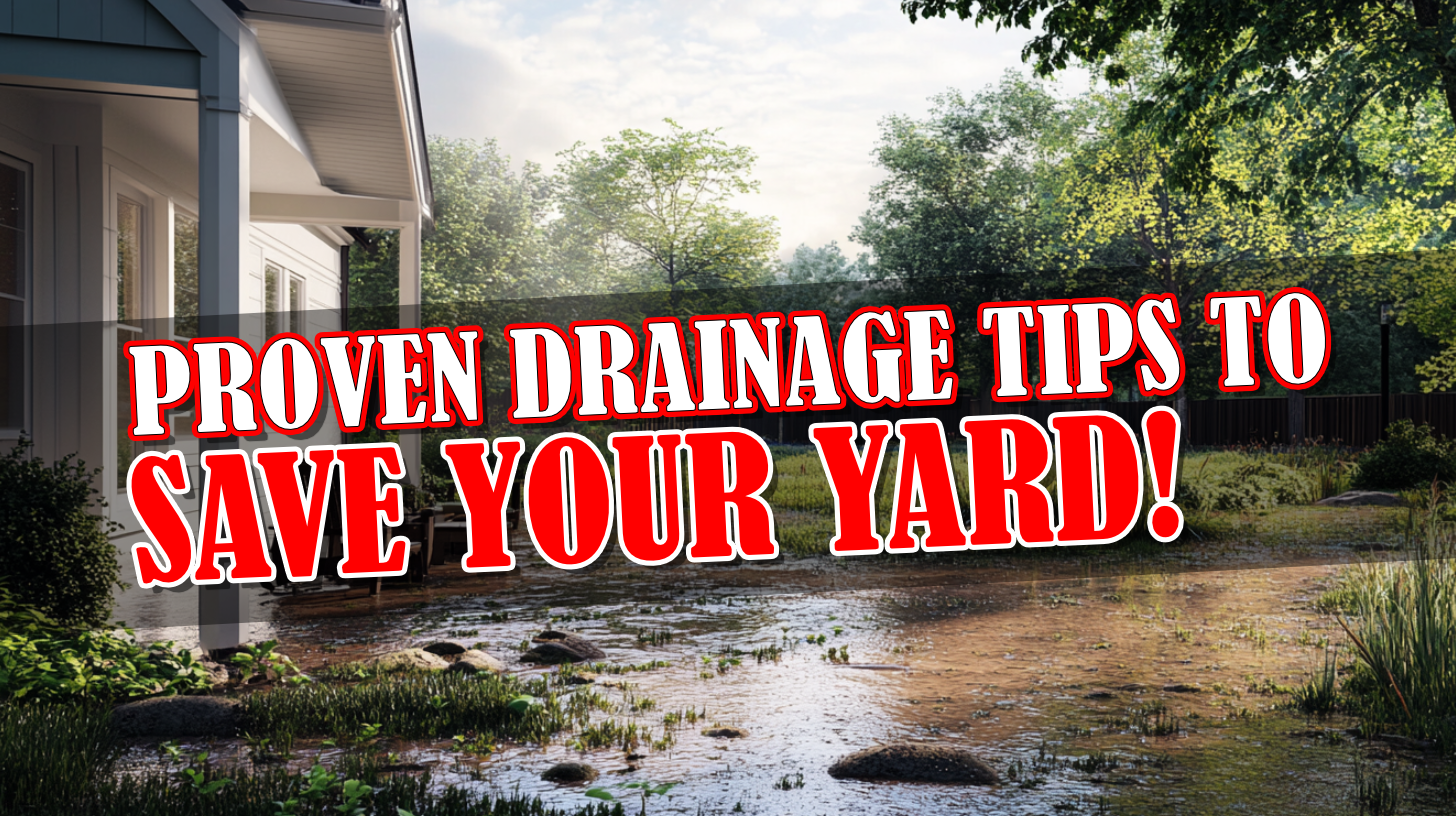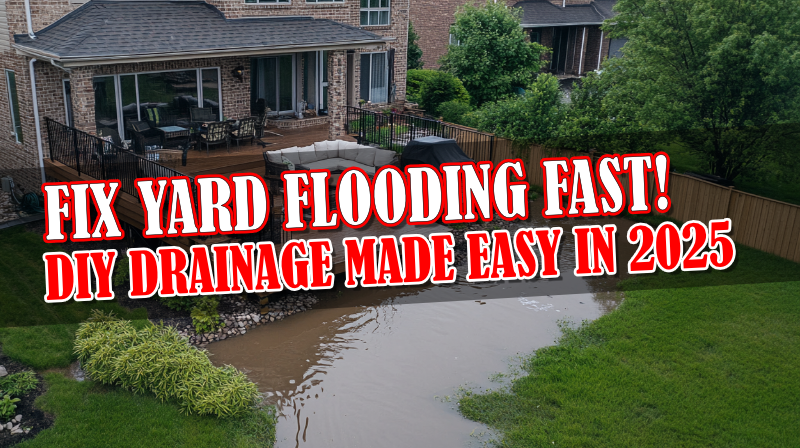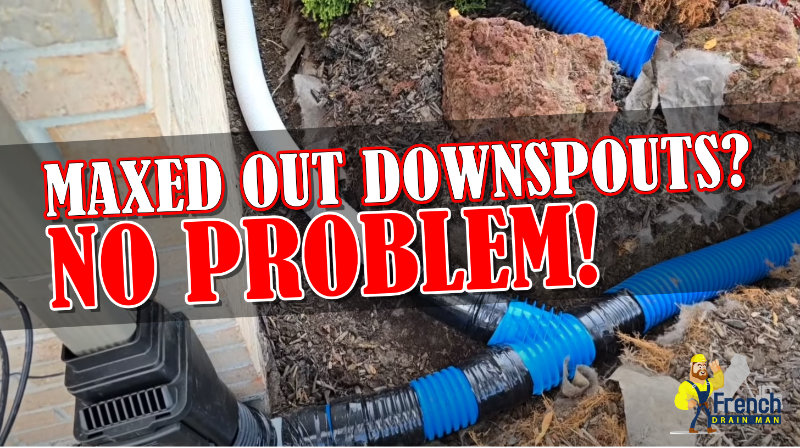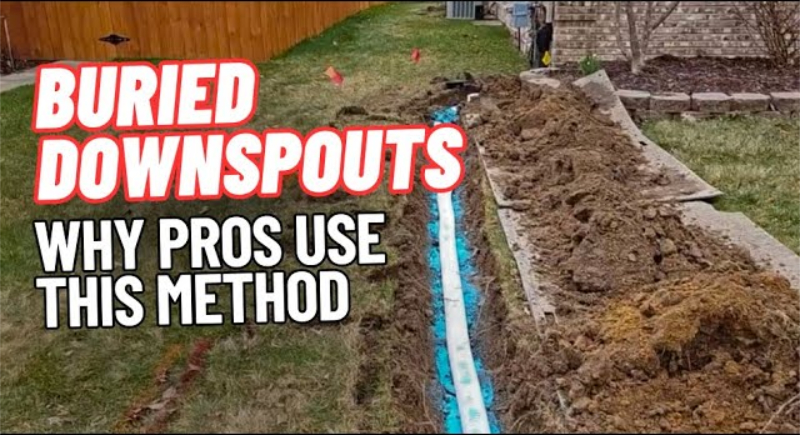How to Build a French Drain the Right Way from A to Z
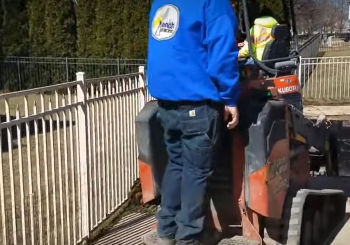 We’re in Macomb Township, MI putting in a French drain. We’re hauling out all the clay that we excavate. None of it’s going back in. We always plywood into the property so that we do not disturb the homeowner’s turf. We want to leave it as we found it.
We’re in Macomb Township, MI putting in a French drain. We’re hauling out all the clay that we excavate. None of it’s going back in. We always plywood into the property so that we do not disturb the homeowner’s turf. We want to leave it as we found it.
The homeowner had a fence up when I came out to do an estimate so that their pet wouldn’t run up and down the fence where it was so muddy.
Water has a hard time if we don’t have a lot of slope, water has a hard time moving through turf grass. This yard has it’s graded properly. It’s got some pitch, but when water just sits on clay it turns to pudding and it’s just a mess for the children and the pets. So as you’ve seen in all our videos, all the dirt is being hauled out, all the clay, it’s no good. You don’t want to put any of it back. You don’t want to put it back on top. When you put the dirt back on top of the drain system, it will appear as if it is working. If you put a pipe in the ground and you go ahead and… say a contractor, this is something that they do all the time, how to equipped to haul out the dirt, so what do they do? They put a pipe in with a little bit of stone and then they’ll fill the rest of the trench up with the clay and put the sod back over top. If they’re using a trencher, let us tear to side all up and destroy the homeowner’s property. And it basically takes a while for that to, to appearance-wise, to get right. It takes, in most cases, months before the yard mends itself. We’ll cut the sod off the top, laid aside, put it right back on top of the system.
But the reason why the drain will actually work if you put a little bit of clay back over the top of the stone is that it’s now all broken up, but it won’t last forever. What happens is the air pockets as that clay settles and compacts, you know the very reason why farmers are always telling. I know there’s, yeah, a lot of farmers that are practicing a, a no-till farming. You know, that’s a whole another thing in itself. But farmers are forced to have to tell because of compaction. Once that soil compacts and all the air pockets are gone, that’s when the system quits working. So that’s why you don’t want to put the clay back over the top of your French drain system. You want to make sure you tell that your contractor that’s doing your install. Look, I want you to remove the clay. All of it. This soil doesn’t perc. It doesn’t perc for a reason. This is poor soil. Get it Outta here. And that’s one of the biggest problems I see out there. Guys are taking the dirt and they’re not equipped to haul it all away. So they’re trying to put the dirt over top of the drain system. So now it doesn’t grab surface water. They’ll actually put inlet basins and aligning with their system to improve it.
Now the inlet basins will take surface water and but, it won’t work nearly as good as if you have a French drain full of stone and you just have two and a half inches of turf with the root off the grass plant over top, it’ll take water, ran for the entire length of the drain.
This way the system not only is more efficient and moves more water, but it never needs maintenance. You may notice that all the other systems with inlet basins, all the different things you see, the guys tell you, you have to maintain this French drain every three to five years. It has to be cleaned out. And in my opinion, that’s if a good contractor put it in. If a good contractor put it in, yeah, doing it, you know, I clean out maintenance, clean out every three to five years would be sufficient. But the sad thing is there are not that many guys putting together good systems. The poor systems need to be cleaned out every year. So when you look at the maintenance costs through these drainage systems, the alternative drainage systems that you see out there. I’ve seen estimates, homeowners have shown me estimates, they’ll get it four or five estimates and they’ll say, look, there was one guy cheaper and you, and then you were the next, and then there was two more than you. But nobody is hauling out as much clay as we do. Nobody is bringing in as much drainage stone. So that tells me that the other guys are really gouging the homeowner when they’re only putting in one-fifth of the stone and they’re only hauling out maybe one-fifth of the dirt that we are.
I’ll show you what this looked like when I got here as far as how this homeowner had to live with this fence across this yard every time it rained and all this, put a little clip in there. I will also come back when we are at that point to where we got the fabric down to go over more of the detail to our system. This is a garden variety system. I know there’s been a lot of comments made. Oh, you’re so lucky. There’s always a storm drain available. Well, in all honesty, there’s, we’re not showing you the other systems. We definitely have some tricks up our sleeve and quite frankly, I consider it job security, but I’m more than happy to give you the foundations and the very basic principles for success.
When we are putting the fabric in and getting the stone down, I’ll explain how we build our systems from A to Z?
All the dirt, well, it’s clay. It was clay here. Nothing but clay. All the clay’s been hauled out. The frost laws are still on, so we’re doing short loads. We just couldn’t wait anymore. I mean, once frost laws go on and we got up, stop and wait for them to come back on. We’ll run all the sump pump line jobs that we have because it’s just PVC pipe that we’re hauling. Right now we’re coring the storm drain catch basin and the guys all get through there with the core drill and they’ll put a piece of schedule 40 and like I’ve shown in a lot of our videos and put hydraulic concrete on both sides. That’s the way they want it.
So as you can see, we have a nonwoven. A lot of people ask me which Geotextile fabric it’s gotta be a non-woven guys, and it must say drainage fabric, not a weed barrier. I’ve seen a lot of videos that landscapers have put up and they’re using the wrong fabric, but they actually built a good system. And I’m thinking to myself, that landscaper just took all that clay out and brought all his stone in and then he wrapped this system with the wrong fabric. You know, you can’t miss on that guys. It’s got to literally be a non-woven geotextile made purpose made for drainage. And I’m using a DOT approved. This is the same fabric that they’re using under highways. They’re putting French drains under all the roadways now, and this is the same fabric, so you can Google it, you can find it. I can’t ship it because the shipping, whether it’s for our pipe or whether it’s for our fabric, is so expensive.
I had a lot of requests to ship this pipe and as soon as they hear the price, they say, yeah, we’ll uh, just by a Dremel tool. And you can buy a Dremel tool and this has eight slots per valley. And you could just go ahead and take one of home Depot’s pipes that has three slides per valley. You can take a Dremel tool and that’s all you gotta do is just remove a little material and you create an inlet now with eight slots per valley, and you want it as thick as a US quarter. That is 11 and a half inches of inlet per linear foot. So that pipe is going to move. That pipe is going to move a lot of water.
We have our pipe in our eight slots. We’re going to start bringing the stone back here. Another controversial topic, putting the stone under your pipe. Yeah. It depends on a deep dig. I don’t know if you can see it to tap this drain.
Now if you’re building a septic field and you have the right pipe, you have two holes at the bottom. That’s how the septic field is built. You have to put some stone in first because those are the only two holes in the pipe, the two that are at the bottom. Now there are eight slots per valley in our yellow. There’s an inlet all the way around this pipe so we can lay it on the bottom. Why I prefer to have it on the bottom. Well, I got the non-woven geotextile fabric so it’s not going to clog the pipe with clay and NDS will tell you that their engineers will tell you that.
I want this trench to empty out. I want all the water to empty out. When these guys put a few inches of stone in the bottom and then they go ahead and they got a few inches of stone under the pipe and they’re going through the sidewall of the storm drain or you know, similar type installation. What happens is you leave a bunch of water in the bottom of this trench so you’re not emptying it out. If you empty out the trench, you’re going to pull. Through capillary action, you’re going to be able to pull water from the clay, which is going to help dry out that, that problem area in your yard, so you want the pipe on the bottom, but you can’t do that unless you use the pipe that has five or eight slots. We use a five slot for applications where people are going to be driving on it because it makes it stronger.
This is a backyard as far as lawn mowers are concerned and things like that. The normal activities that a backyard sees, and even if a vehicle, some vehicle traffic is not a problem. It’s just when it’s going to be expected on a regular basis I’ll go to the five slots and then we use the five slot behind all our retaining walls.
In Michigan here, if we don’t drain these French drains out in the wintertime, the system won’t perform when you need it because it will have so much ice at the bottom.
The guys have been packing the stone on the side of the pipe. Stone is 99% compacted, so unlike the dirt drains are when we do a sump pump line, there’s gonna be no settling that causes saddling, which is when you end up with a dip. We’re going to bring this up with stone and then pin it like you’ve seen in our other videos so that it’s fully contained. A fully contained French drain doesn’t need maintenance. We don’t have a service crew, we don’t have a service truck. We never see our systems again. Once we build them, they’re maintenance-free.
So we’re building a system for the same price or maybe even less than our competitors are building these systems with inlet basins. And then you’re going to end up on some sort of maintenance schedule. So whether it’s a yearly schedule or every three years, you got to factor those costs in. This system here is maintenance free. It’ll move more water than a system with inlets because the entire length of this drain, the water is going to run through this stone. The entire length of the system is going to take the surface water in as well as the subsurface water. So this argument that you’re going to get the water to go down to the bottom and then arises. Okay, if you just have inlet basins, that’s it, just a few and let basins every 10 feet, you put an inlet basin in line, you’re only grabbing surface water with that inlet basin.
To advertise that. Okay? So we’re gonna get the water in the subsurface in this clay that doesn’t work. I don’t think that would work in any soil that didn’t perc well. If you don’t have good percolation, don’t put the soil back in. And don’t just use an inlet base in every 10 feet. If you want to scream in French drain system, build them the way we’re showing you. We have dozens of guys across the nation now that have adopted our drain. We’re hearing from them. They’re telling us all the success they’re having with it. It’s a maintenance-free French drain. Once it’s installed, you’re done. There’s no more cost to you the homeowner. No more headaches where they’re plugged and you got water standing in the near your yard.
Okay. We did our Burrito wrap and pin the non-woven geotextile fabric. This is the four-ounce. We’re going to move a lot of water with this. The stone that you’ve seen, that’s an inch and a half to three-quarter inch 6A stone that is approved by the health department for septic fields. I want a stone that goes through a wash plant and I, it’s been screened and that’s the only way I can get it. So I’m buying, I’m buying the stone that the health department approves. And when I mentioned earlier that the eight-slot has 11 and a half inches of inlet, I mean 11 and a half inches square. So this pipe has 11 and a half inches square of an inlet in a linear foot. That is absolutely ridiculous. I mean it’s, you’re moving water.
So there was the before how the homeowner had to live. You have to put that up every time it rains and you have to take it down when you finally can mow your grass and it’s just a huge inconvenience. Reclaim your yard, get back your yard, put in a good French drain.
Now we did all the sprinkler restoration to this. The guys just finished. This was our morning job and they moved on to their afternoon job. But look how nice that looks. We piece the sod back together. It’s like a puzzle. Just goes right back together. Look how clean that is. Now, as soon as we get some, some warmer weather where the grass will actually grow and green up, that’ll mend itself really, really fast.
So all my competitors are telling the homeowners and including it as an extra to take care of sprinklers. They’re saying if they do the sprinkler restoration, the sprinkler repair, it’s going to be $95 to $105 per man hour plus parts. When we put in a French drain, we give you a price. We do that French drain from A to Z and we take care of the irrigation. It’s included in our installation.
If you’d like to see more videos like this, give us a thumbs up. If this video gets a lot of likes, I’ll do plenty more like it, but I have to know it’s what our subscribers want.
If you are located in north Macomb County, Michigan, and North Oakland County, Michigan, and you don’t want to get your hands dirty, like the service provided, give us a call at 248-505-3065.





